High-Thermal-Conductivity AlN Ceramics Prepared from Octyltrichlorosilane-Modified AlN Powder
Abstract
1. Introduction
2. Materials and Methods
2.1. Materials
2.2. Surface Modification of AlN Powder
2.3. Preparation of AlN Ceramics
2.4. Characterization
3. Results and Discussion
3.1. Surface Modification of AlN Powder
3.2. Microstructure and Phase of AlN Ceramics
3.3. Thermal Conductivity of AlN Ceramics
4. Discussion
5. Conclusions
Author Contributions
Funding
Institutional Review Board Statement
Informed Consent Statement
Data Availability Statement
Acknowledgments
Conflicts of Interest
References
- Chiu, C.W. Highly Thermally Conductive Epoxy Composites with AlN/BN Hybrid Filler as Underfill Encapsulation Material for Electronic Packaging. Polymers 2022, 14, 2950. [Google Scholar]
- Hassan, S.; Ahmed, S.; Ali, M.; Fahad, S. Advanced Electrical Characterization of AlN/Si Based Heterogeneous Junction for Photonic Applications. Mat. Sci. Semicon Proc. 2022, 138, 106292. [Google Scholar] [CrossRef]
- Matsumae, T.; Kurashima, Y.; Higurashi, E.; Nishizono, K.; Takagi, H. Room Temperature Bonding of Aluminum Nitride Ceramic and Semiconductor Substrate. Ceram. Int. 2020, 46, 1099–1118. [Google Scholar] [CrossRef]
- Shi, Z.M.; Qi, Z.B.; Zang, H.; Jiang, K.; Chen, Y.; Jia, Y.P.; Wu, T.; Zhang, S.L.; Sun, X.J.; Li, D.B. Point Defects in Monolayer h-AlN as Candidates for Single-Photon Emission. ACS Appl. Mater. Inter. 2021, 13, 37380–37387. [Google Scholar] [CrossRef] [PubMed]
- Jackson, T.B.; Virkar, A.V.; More, K.L.; Dinwiddie, R.B.; Cutler, R.A. High-Thermal-Conductivity Aluminum Nitride Ceramics: The Effect of Thermodynamic, Kinetic, and Microstructural Factors. J. Am. Ceram. Soc. 1997, 80, 1421–1435. [Google Scholar] [CrossRef]
- Slack, G.A.; Schowalter, L.J.; Morelli, D.; Freitas, J.A. Some Effects of Oxygen Impurities on AlN and GaN. J. Cryst. Growth. 2002, 246, 287–298. [Google Scholar] [CrossRef]
- Chu, A.M.; Zhao, Y.P.; Ud-din, R.; Hu, H.R.; Zhi, Q.; Wang, Z.R. Carbon-containing Droplet Combustion–Carbothermal Synthesis of Well-Distributed AlN Nanometer Powders. J. Am. Chem. Soc. 2022, 105, 5999–6006. [Google Scholar] [CrossRef]
- Rogers, S.; Dargusch, M.; Kent, D. Impacts of Temperature and Time on Direct Nitridation of Aluminium Powders for Preparation of AlN Reinforcement. Materials 2023, 16, 1583. [Google Scholar] [CrossRef]
- Lee, K.B.; Kim, J.J.; Shim, C.H.; Kim, Y.H.; Choi, H.J.; Ahn, J.P. Low-temperature Synthesis of High-Purity AlN from Al Powder. J. Mater. Res. Technol. 2022, 21, 4526–4536. [Google Scholar] [CrossRef]
- Liu, L.; He, B.Y.; Chen, X.M.; Zhao, Z.Q.; Yin, Q.; Xu, P.L.; Yang, B.; Xu, B.Q.; Liu, D.C. Thermodynamic and Kinetic Analyses of Vacuum Synthesis of AlN by The Alumina Carbothermal Reduction Nitridation Method. J. Am. Chem. Soc. 2022, 105, 3850–3861. [Google Scholar] [CrossRef]
- Xu, Y.L.; Zhou, Z.Q.; Chen, X.M.; Han, C.C.; Yang, B.; Xu, B.Q.; Liu, D.C. Ultrafine AlN Synthesis by Alumina Carbothermal Reduction under Vacuum: Mechanism and Experimental Study. Powder Technol. 2021, 377, 843–846. [Google Scholar] [CrossRef]
- Li, J.W.; Matsumaru, K.; Ishizaki, C.; Ishizaki, K. Diffuse Reflectance Infrared Fourier Transform Spectroscopy of Commercial AlN Powders in Vacuum up to 700 °C. J. Am. Ceram. Soc. 2006, 89, 2537–2541. [Google Scholar] [CrossRef]
- Li, J.W.; Nakamura, M.; Shirai, T.; Matsumaru, K.; Ishizaki, K. Mechanism and Kinetics of Aluminum Nitride Powder Degradation in Moist Air. J. Am. Ceram. Soc. 2006, 89, 937–943. [Google Scholar] [CrossRef]
- Baraton, M.I.; Chen, X.; Gonsalves, K. FT-IR Characterization of the Acidic and Basic Sites on a Nanostructured Aluminum Nitride Surface. MRS Proc. 2011, 454, 59. [Google Scholar] [CrossRef]
- Kocjan, A.; Dakskobler, A.; Kosmač, T. Evolution of Aluminum Hydroxides in Diluted Aqueous Aluminum Nitride Powder Suspensions. Cryst. Growth Des. 2012, 12, 1299–1307. [Google Scholar] [CrossRef]
- Kameshima, Y.; Kuramochi, S.; Yasumori, A.; Okada, K. Analysis of Surface State and Stability during Storage of AlN Powders by X-ray Photoelectron Spectroscopy. J. Ceram. Soc. Jpn. 1999, 106, 749–753. [Google Scholar] [CrossRef]
- Hu, L.; Wang, Y.; Wang, S. Aluminum Nitride Surface Functionalized by Polymer Derived Silicon Oxycarbonitride Ceramic for Anti-Hydrolysis. J. Alloys Compd. 2019, 772, 828–833. [Google Scholar] [CrossRef]
- Ganesh, I.; Olhero, S.M.; Araújo, A.B.; Correia, M.R.; Sundararajan, G.; Ferreira, J.M.F. Chemisorption of Phosphoric Acid and Surface Characterization of As Passivated AlN Powder Against Hydrolysis. Langmuir 2008, 24, 5359–5365. [Google Scholar] [CrossRef]
- Olhero, S.; Novak, S.; Oliveira, M. A Thermo-Chemical Surface Treatment of AlN Powder for the Aqueous Processing of AlN Ceramics. J. Mater. Res. 2004, 19, 746–751. [Google Scholar] [CrossRef]
- Morisada, Y.; Sakurai, T.; Miyamoto, Y. A New Water-Resistant Coating for AlN Powders. Int. J. Appl. Ceram. Tec. 2004, 1, 374–380. [Google Scholar] [CrossRef]
- Egashira, M.; Shimizu, Y.; Takatsuki, S. Chemical Surface Treatments of Aluminium Nitride Powder Suppressing Its Reactivity With Water. J. Mater. Sci. Lett. 1991, 10, 994–996. [Google Scholar] [CrossRef]
- Krnel, K.; Kosmač, T. Reactivity of Aluminum Nitride Powder in Dilute Inorganic Acids. J. Am. Ceram. Soc. 2010, 83, 1375–1378. [Google Scholar] [CrossRef]
- Xu, Z.Z.; Qu, X.H.; Duan, H.B. Influence of Silane on Anti-hydrolytic Property of AlN Powders. Electron. Compon. Mater. 2004, 12, 7–9. [Google Scholar]
- Shen, M. Determination of The Amount of Physical Adsorption of Water Vapour on Platinum-Iridium Surfaces. Metrologia 2015, 52, 236–239. [Google Scholar]
- Deng, L.; Qiao, L.; Zheng, J.W.; Ying, Y.; Yu, J.; Li, W.C.; Che, S.L.; Cai, W. Injection Molding, Debinding and Sintering of ZrO2 Ceramic Modified by Silane Couping Agent. J. Eur. Ceram. Soc. 2019, 40, 1566–1573. [Google Scholar] [CrossRef]
- Dalmau, R.; Collazo, R.; Mita, S.; Sitar, Z. X-ray Photoelectron Spectroscopy Characterization of Aluminum Nitride Surface Oxides: Thermal and Hydrothermal Evolution. J. Electron. Mater. 2007, 36, 414–419. [Google Scholar] [CrossRef]
- Rosenberger, L.; Baird, R.; McCullen, E.; Shreve, G. XPS Analysis of Aluminum Nitride Films Deposited By Plasma Source Molecular Beam Epitaxy. Surf. Interface Anal. 2008, 40, 1254–1261. [Google Scholar] [CrossRef]
- Balasubramanian, C.; Bellucci, S.; Cinque, G.; Marcelli, A. Characterization of Aluminium Nitride Nanostructures by XANES and FTIR Spectroscopies with Synchrotron Radiation. J. Phys. Condens. Mat. 2006, 18, S2095–S2104. [Google Scholar] [CrossRef]
- Binner, J.; Zhang, Y.H. Surface Chemistry and Hydrolysis of a Hydrophobic-Treated Aluminium Nitride Powder. Ceram. Int. 2005, 31, 469–474. [Google Scholar] [CrossRef]
- Yuan, Y.; Chi, Z.F.; Tang, B.; Li, E.Z.; Zhang, S.R. Research on HydrophobicityTreatment of Aluminum Nitride Powder and The Fabrication and Characterization of AlN/PTFE Composite Substrates. J. Mater. Sci. Mater. Electron. 2018, 29, 14890–14896. [Google Scholar] [CrossRef]
- Zhang, Z.; Wang, H.; Provis, J.L. Quantitative Study of The Reactivity of Fly Ash in Geopolymerization by FTIR. J. Sustain. Cem. Based. 2012, 1, 154–166. [Google Scholar] [CrossRef]
- Kocjan, A.; Dakskobler, A.; Budič, B.; Kosmač, T. Suppressed Reactivity of AlN Powder in Water at 5 °C. J. Am. Ceram. Soc. 2013, 96, 1032–1034. [Google Scholar] [CrossRef]
- Kobayashi, R.; Oh-Ishi, K. Analyses of Microstructure and Oxygen Content Effects on Thermal Conductivity of AlN Ceramics by using Slack’s Plot. Key Eng. Mater. 2010, 484, 61–64. [Google Scholar] [CrossRef]
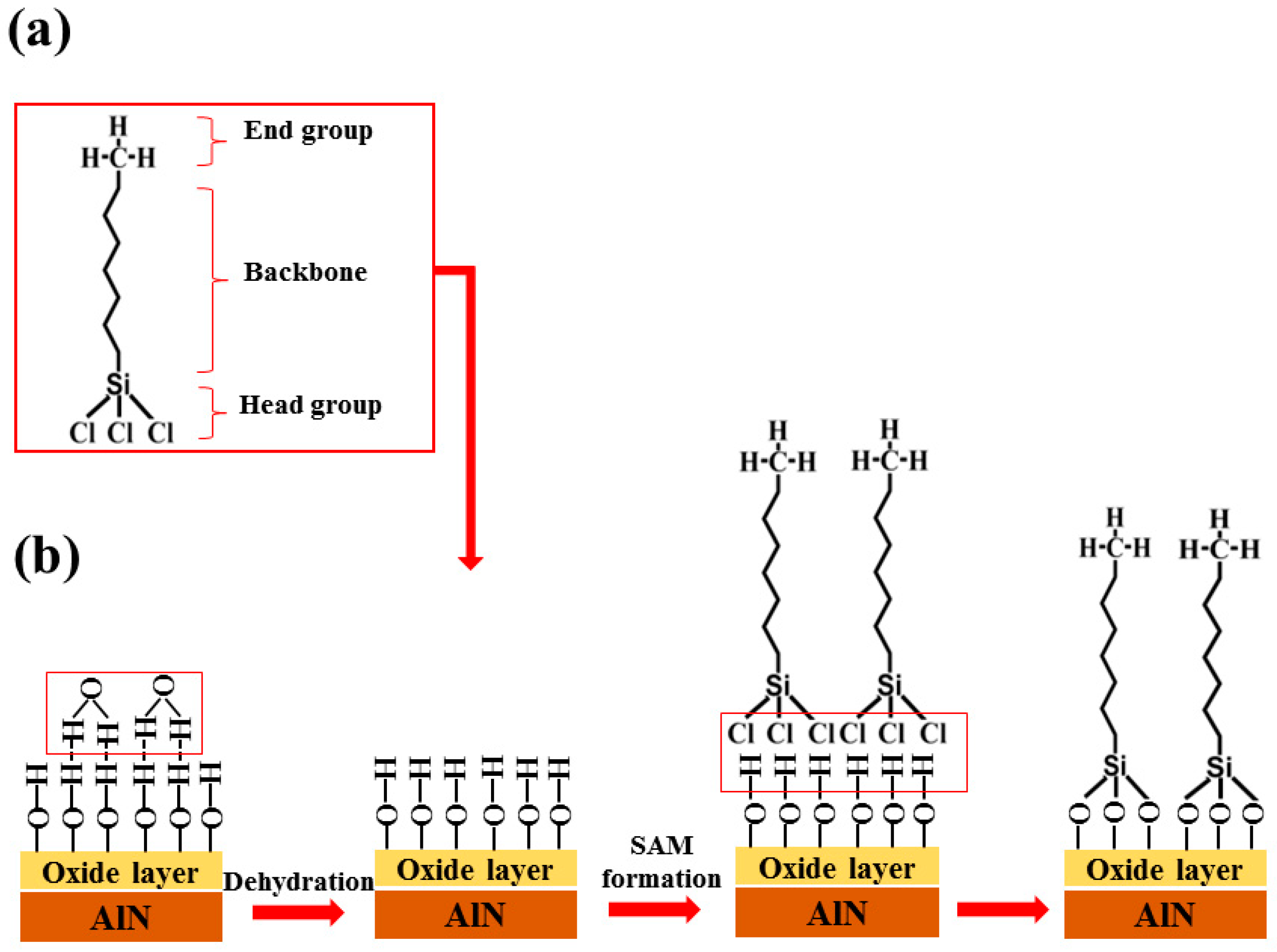
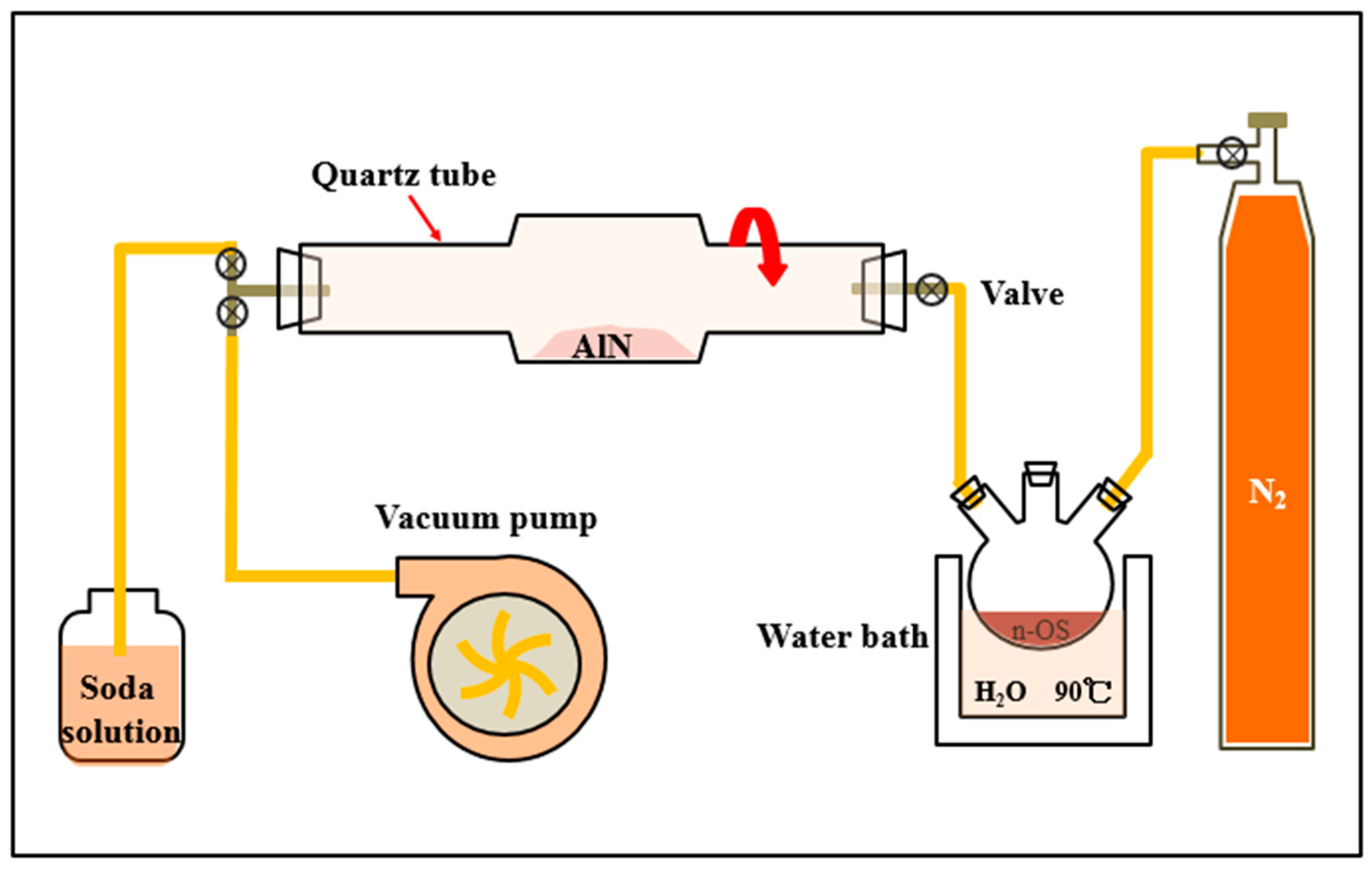
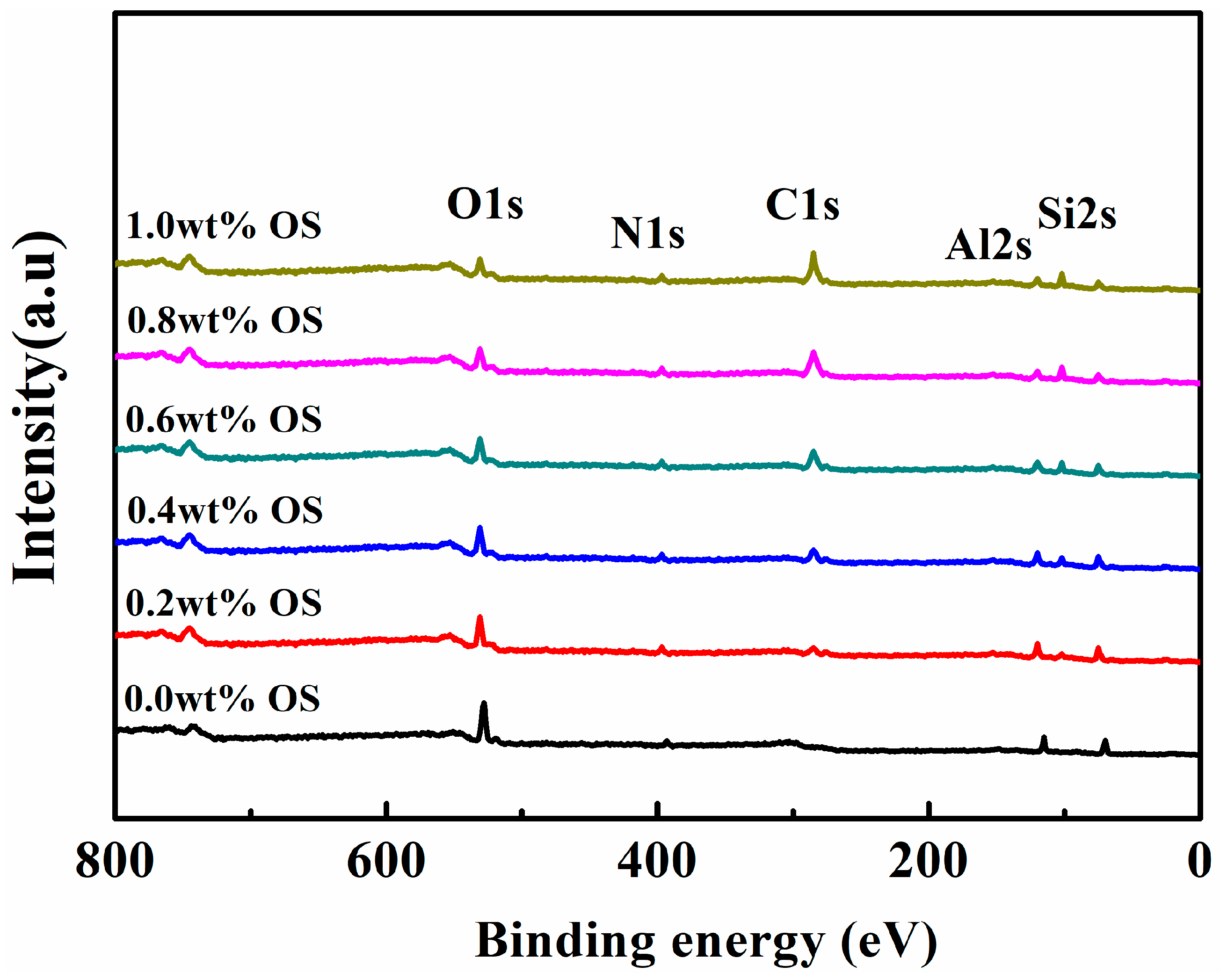


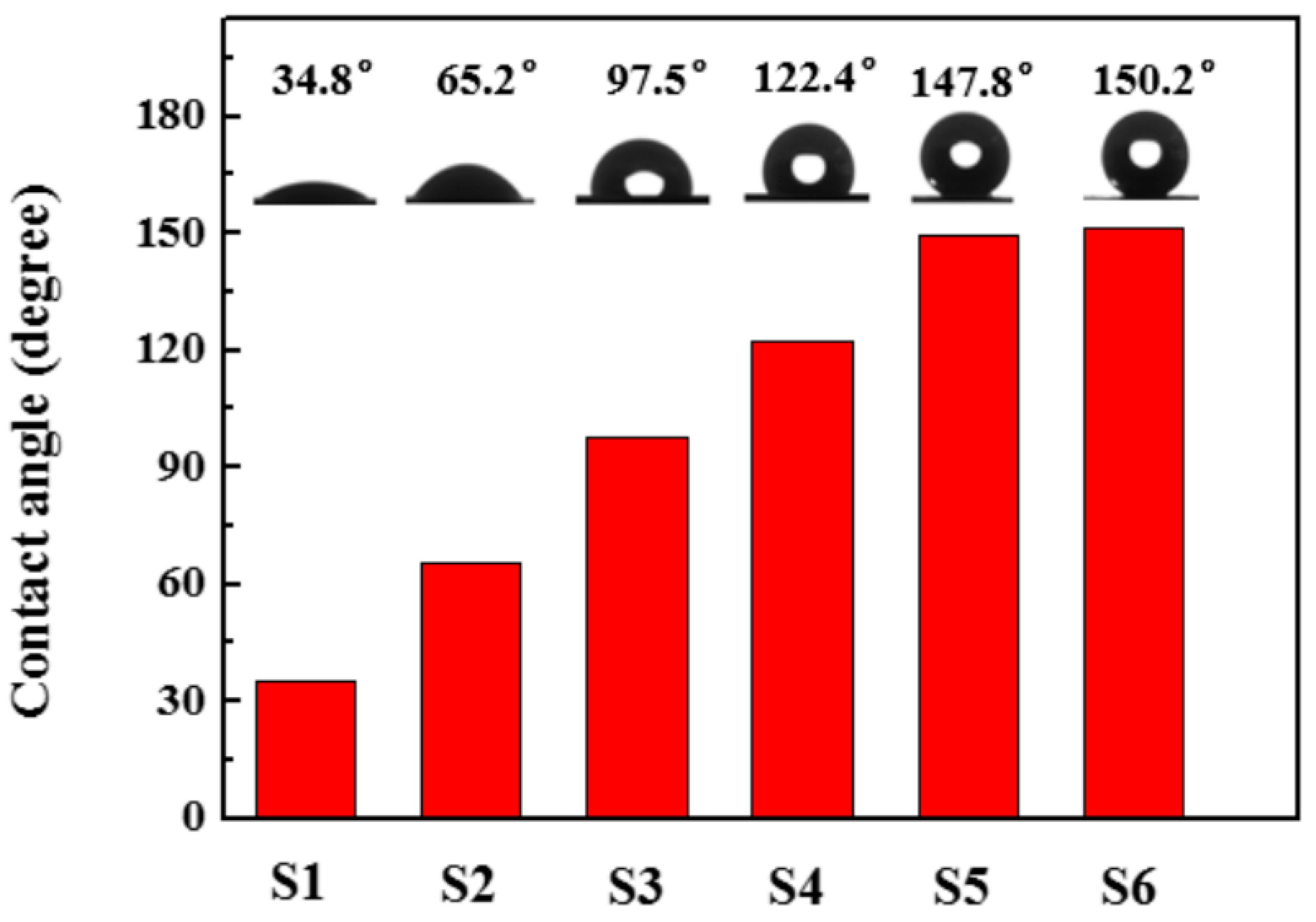
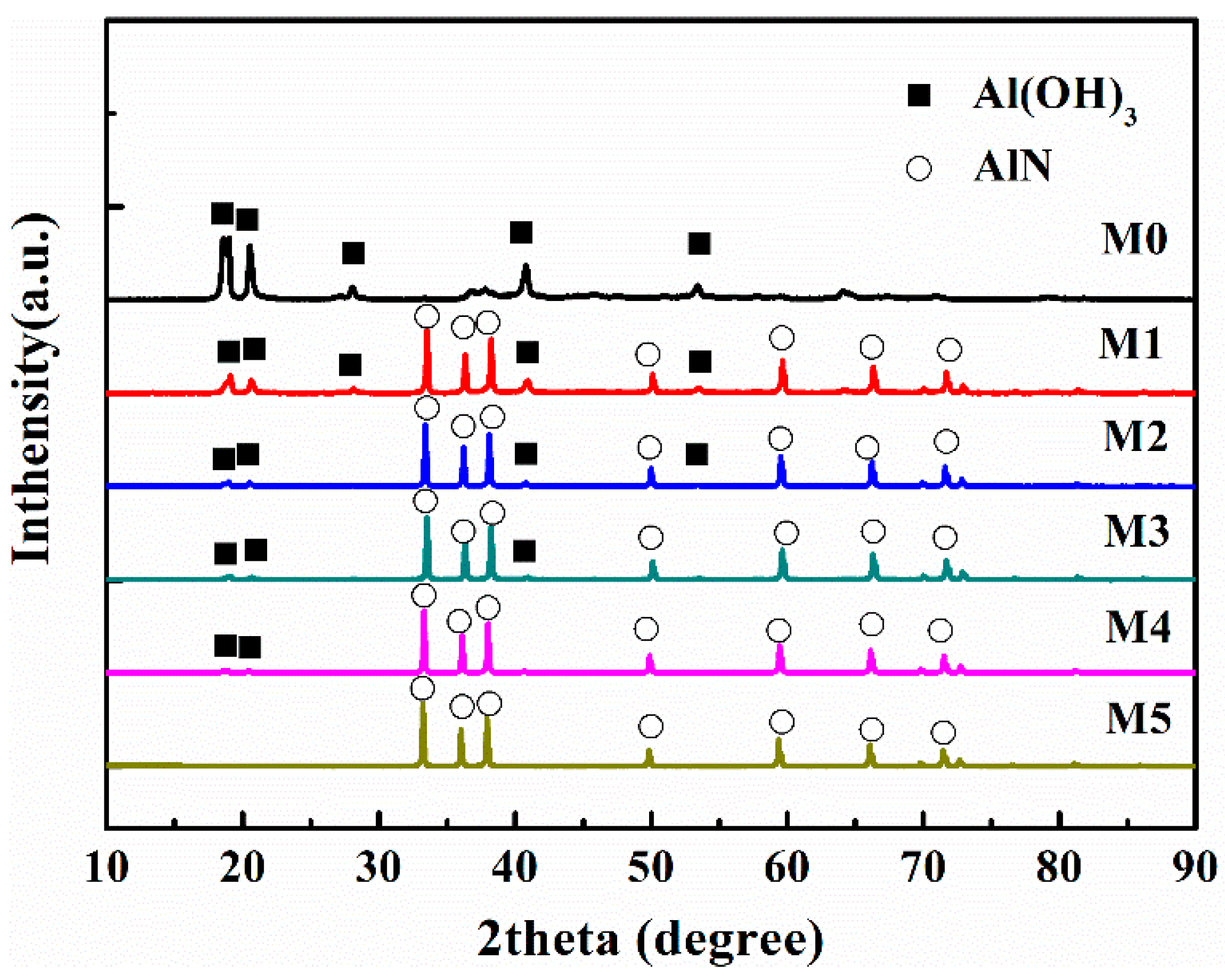
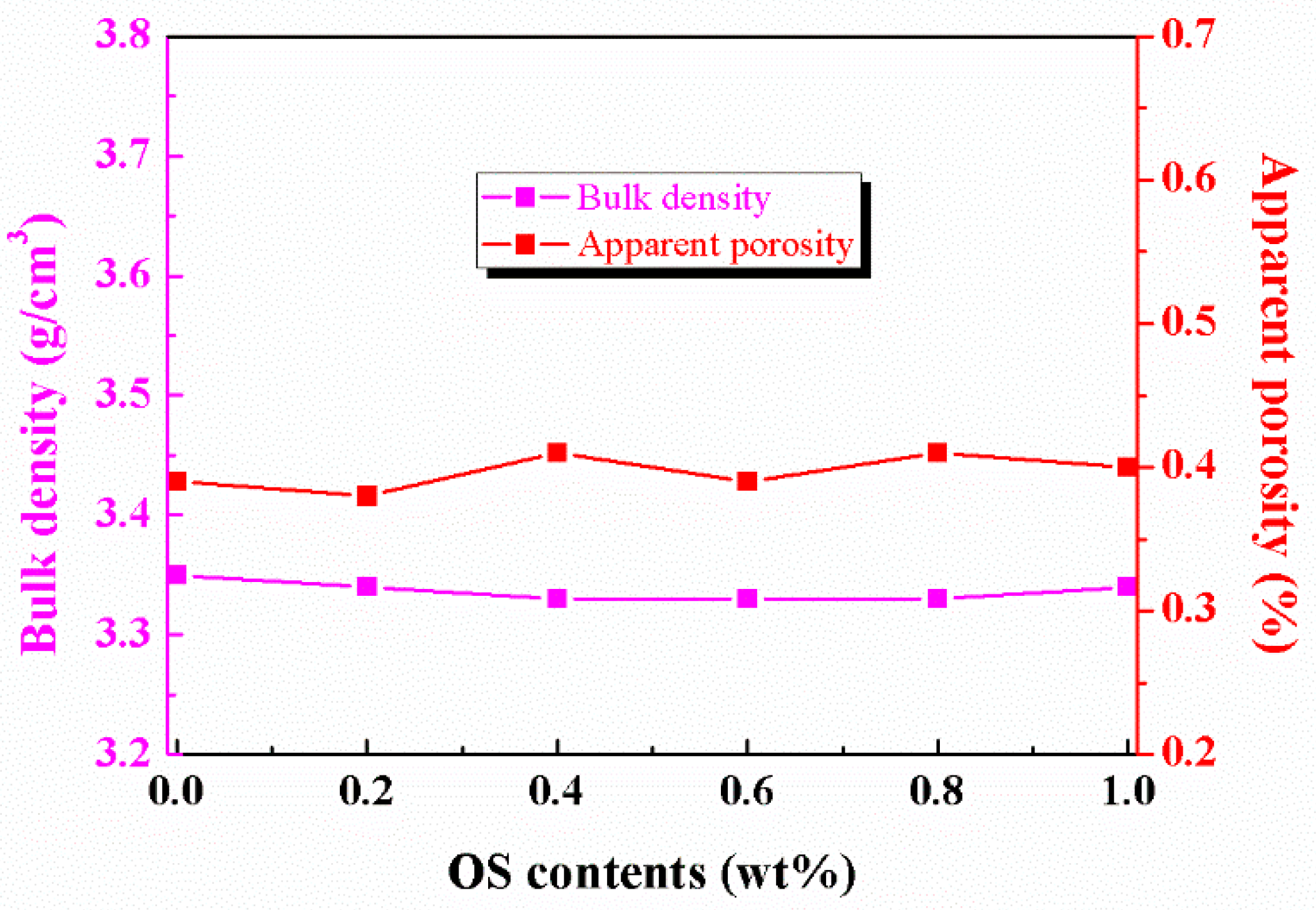
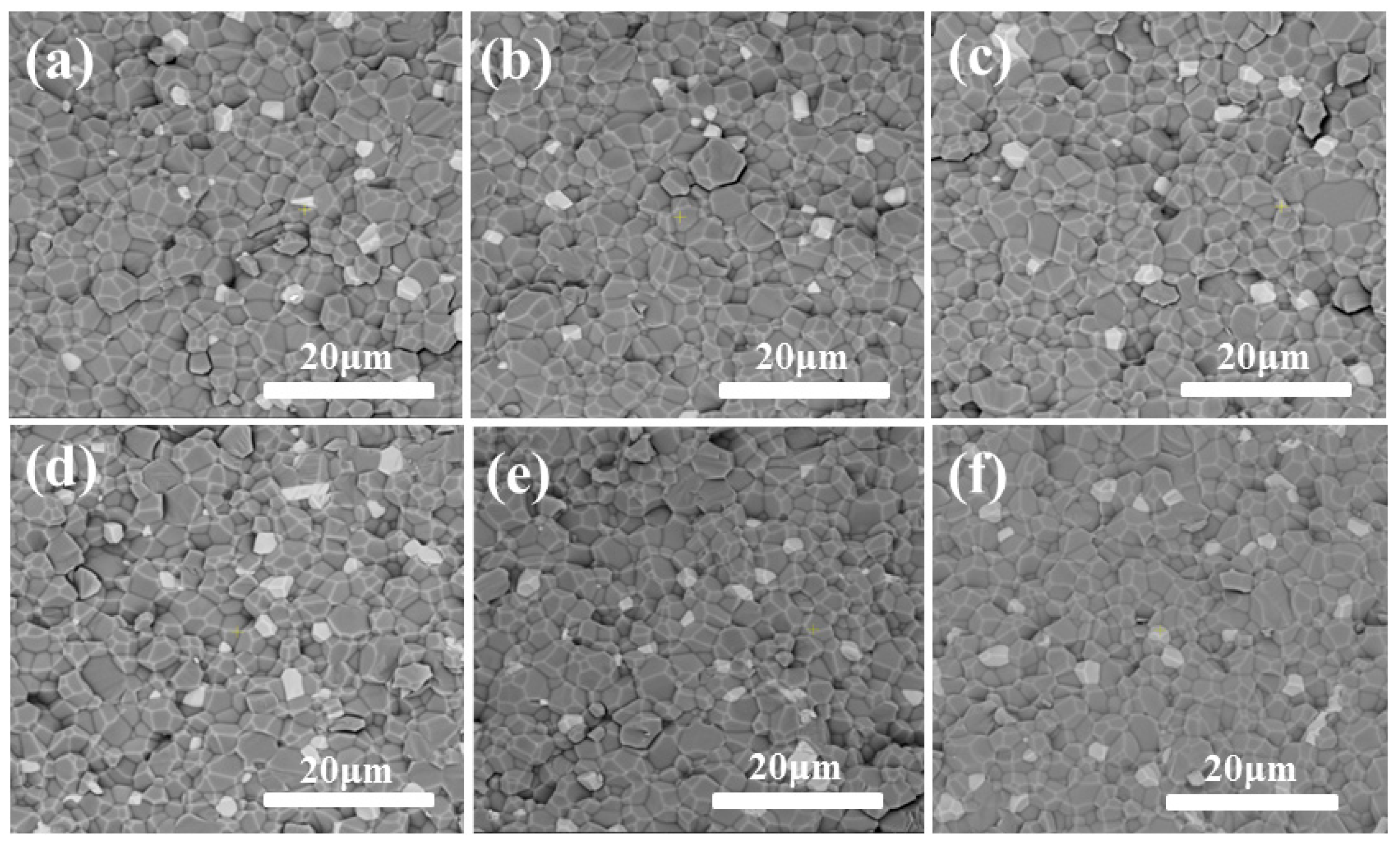
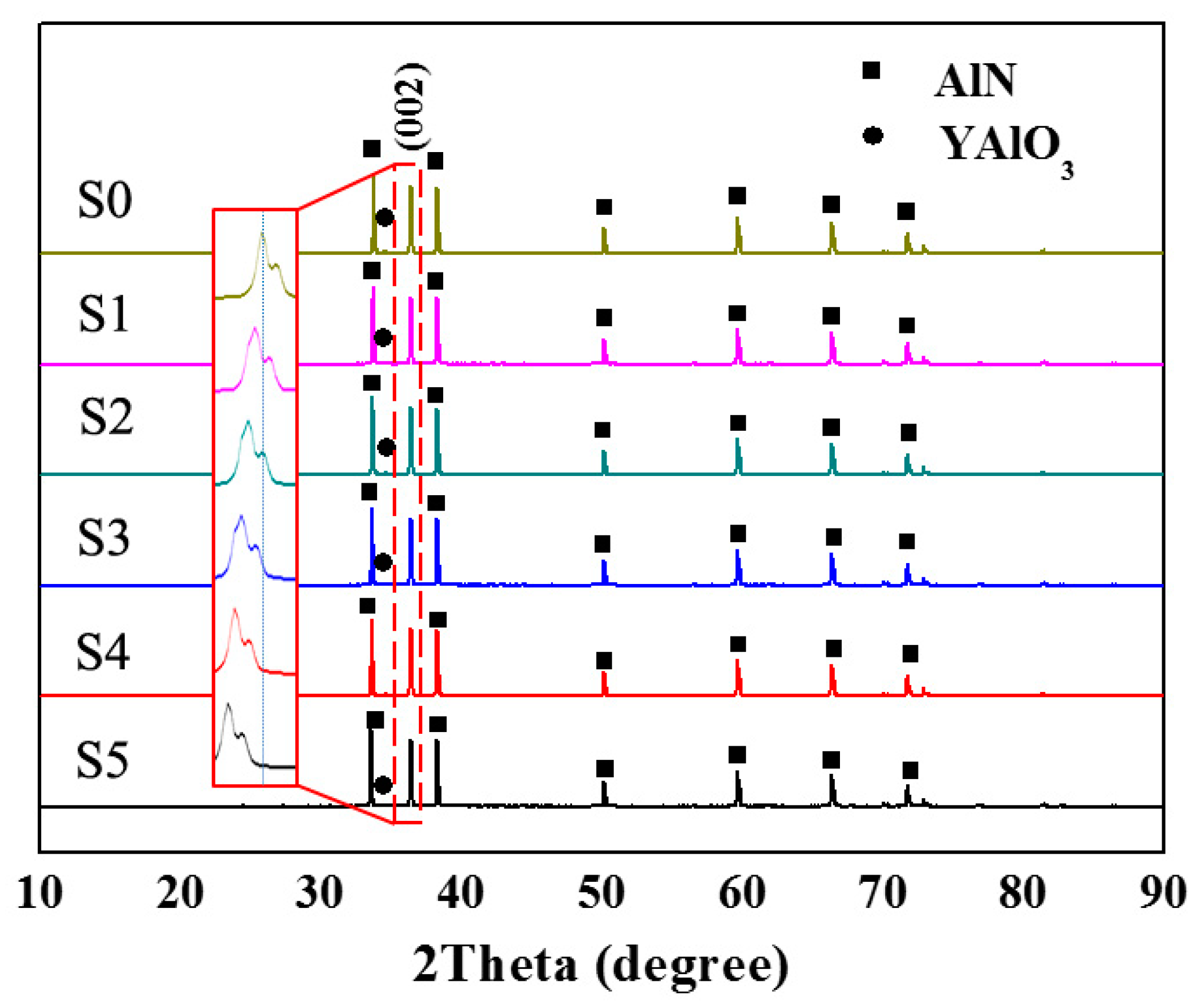
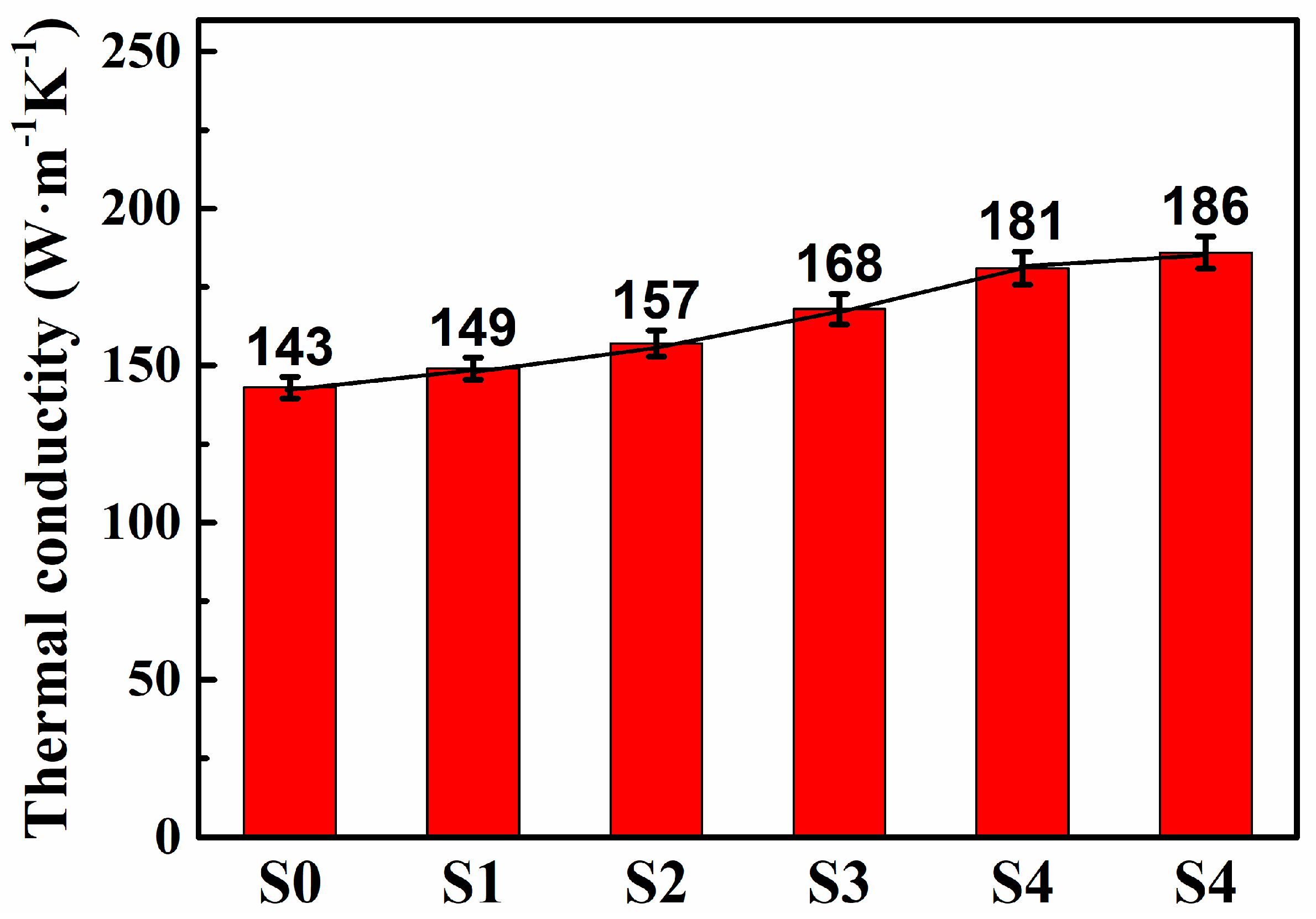
| Elements | Al | N | O | C | Ca | Fe | Si |
|---|---|---|---|---|---|---|---|
| content | 65.5% | 33.5% | 0.9% | 0.06% | 300 ppm | <100 ppm | <30 ppm |
| Samples | OS Content (wt%) | Mass Loss (%) | OS Grafting (wt%) | |
|---|---|---|---|---|
| 50–250 °C | 250–500 °C | |||
| M0 | 0.0 | 0.36 | 0.21 | 0.0 |
| M1 | 0.2 | 0.34 | 0.25 | 0.09 |
| M2 | 0.4 | 0.33 | 0.33 | 0.26 |
| M3 | 0.6 | 0.32 | 0.41 | 0.44 |
| M4 | 0.8 | 0.30 | 0.50 | 0.63 |
| M5 | 1.0 | 0.30 | 0.58 | 0.81 |
| AlN Powder | Surface Element Abundance (at%) | ||||
|---|---|---|---|---|---|
| Al | N | O | C | Si | |
| M0 | 50.12 | 32.47 | 17.41 | - | - |
| M1 | 45.14 | 29.93 | 15.41 | 8.39 | 1.13 |
| M2 | 41.76 | 24.74 | 13.41 | 17.90 | 2.19 |
| M3 | 37.92 | 19.41 | 11.41 | 27.86 | 3.40 |
| M4 | 25.87 | 15.93 | 8.06 | 44.65 | 5.49 |
| M5 | 23.43 | 14.47 | 7.58 | 49.03 | 5.86 |
Disclaimer/Publisher’s Note: The statements, opinions and data contained in all publications are solely those of the individual author(s) and contributor(s) and not of MDPI and/or the editor(s). MDPI and/or the editor(s) disclaim responsibility for any injury to people or property resulting from any ideas, methods, instructions or products referred to in the content. |
© 2023 by the authors. Licensee MDPI, Basel, Switzerland. This article is an open access article distributed under the terms and conditions of the Creative Commons Attribution (CC BY) license (https://creativecommons.org/licenses/by/4.0/).
Share and Cite
Li, G.; Li, B.; Ren, B.; Li, Y.; Chen, H.; Chen, J. High-Thermal-Conductivity AlN Ceramics Prepared from Octyltrichlorosilane-Modified AlN Powder. Processes 2023, 11, 1186. https://doi.org/10.3390/pr11041186
Li G, Li B, Ren B, Li Y, Chen H, Chen J. High-Thermal-Conductivity AlN Ceramics Prepared from Octyltrichlorosilane-Modified AlN Powder. Processes. 2023; 11(4):1186. https://doi.org/10.3390/pr11041186
Chicago/Turabian StyleLi, Guangqi, Bin Li, Bo Ren, Yang Li, Haiyang Chen, and Junhong Chen. 2023. "High-Thermal-Conductivity AlN Ceramics Prepared from Octyltrichlorosilane-Modified AlN Powder" Processes 11, no. 4: 1186. https://doi.org/10.3390/pr11041186
APA StyleLi, G., Li, B., Ren, B., Li, Y., Chen, H., & Chen, J. (2023). High-Thermal-Conductivity AlN Ceramics Prepared from Octyltrichlorosilane-Modified AlN Powder. Processes, 11(4), 1186. https://doi.org/10.3390/pr11041186









